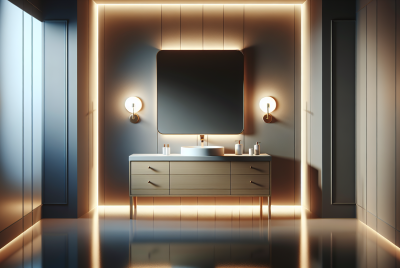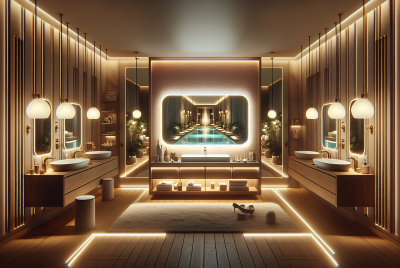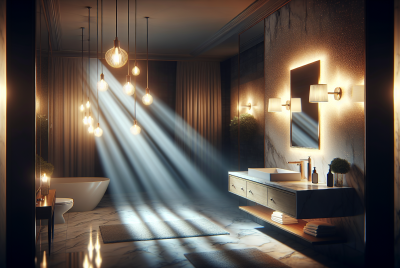The Ultimate Guide To LED Bathroom Lighting
Transform your bathroom into a luxurious and stylish oasis with the help of the ultimate guide to LED bathroom lighting. Whether you prefer a soft and moody ambiance or a bright and energizing space, this comprehensive guide will take you through everything you need to know about LED lighting options for your bathroom. From choosing the right fixtures to understanding the various types of LED bulbs available, this guide will ensure that your bathroom lighting not only looks fantastic but also enhances your daily routine. Say goodbye to dull and uninspiring lighting – it’s time to revolutionize your bathroom with LED technology.
1. Understanding LED Lighting
1.1 How LED Lighting Works
LED lighting, or Light Emitting Diode lighting, works by the process of electroluminescence. When an electrical current passes through a semiconductor material, it emits light. LED lights consist of a semiconductor chip that is encased in a transparent epoxy resin. When an electric current is applied to this semiconductor chip, it emits light in the form of photons. Unlike other traditional lighting options, such as incandescent bulbs, LEDs do not rely on a filament that can burn out over time. This makes them more durable and long-lasting.
1.2 Benefits of LED Lighting
LED lighting offers numerous benefits for bathroom lighting. Firstly, LED lights are highly energy-efficient. They consume significantly less energy compared to traditional lighting options, saving you money on your electricity bills. LED lights also have a longer lifespan, often lasting up to 50,000 hours or more, which means less frequent replacements and reduced maintenance costs. Additionally, LED lights are known for their instant brightness and do not require any warm-up time. They also emit very little heat, making them safer to use in enclosed spaces like bathrooms. Lastly, LED lights are available in a wide range of colors and can be dimmable, allowing you to create the desired ambiance in your bathroom.
1.3 Types of LED Lights
LED lights come in various types, each suited for different purposes. Some common types of LED lights include:
-
LED Bulbs: These are versatile and can be used as a direct replacement for incandescent bulbs. They are available in different shapes and sizes to fit different fixtures.
-
LED Strips: These flexible strips of LED lights are ideal for adding accent lighting or under cabinet lighting in the bathroom. They can be easily cut to size and provide a uniform glow.
-
LED Downlights: These recessed lights are commonly used for general or ambient lighting in the bathroom. They are usually installed in the ceiling and provide a sleek, modern look.
-
LED Vanity Lights: These are specifically designed for lighting up bathroom vanities. They come in various styles and sizes, providing both functional and decorative lighting.
-
LED Mirror Lights: These lights are specially designed to illuminate bathroom mirrors. They are typically mounted directly on the mirror or on the wall surrounding it.
-
LED Shower Lights: Waterproof LED lights that are designed to be installed in the shower area. They provide illumination while ensuring water resistance.
-
LED Task Lighting: These lights are focused on providing bright and focused illumination for specific tasks, such as shaving or applying makeup.
2. Factors to Consider Before Choosing LED Bathroom Lighting
2.1 Bathroom Size and Layout
Before selecting LED bathroom lighting, it’s important to consider the size and layout of your bathroom. A larger bathroom may require more lighting fixtures to ensure adequate brightness, while a smaller bathroom may be better suited with fewer fixtures. Additionally, the layout of the bathroom, such as the placement of the shower, vanity, and mirror, should be taken into account to determine the optimal placement of lighting fixtures.
2.2 Lighting Levels and Mood
Think about the desired lighting levels and mood you want to create in your bathroom. Consider whether you prefer bright, task-oriented lighting or a softer, more relaxing ambiance. This will help guide your choice of LED lighting fixtures and determine the brightness and color temperature of the bulbs.
2.3 Color Temperature
LED lights come in different color temperatures, which are measured in Kelvin (K). Color temperatures can range from warm white (around 2700K) to cool white (around 5000K). Warmer color temperatures create a cozy and comforting atmosphere, while cooler color temperatures provide a brighter and more energetic feel. Consider the overall design and color scheme of your bathroom when choosing the color temperature of your LED lights.
2.4 Energy Efficiency and Lifespan
LED lights are renowned for their energy efficiency and long lifespan. When selecting LED bathroom lighting, look for fixtures and bulbs with high energy efficiency ratings. This will not only save you money on energy bills but also contribute to a more sustainable environment. Additionally, consider the lifespan of the LED lights to minimize the frequency of replacements and reduce long-term maintenance costs.
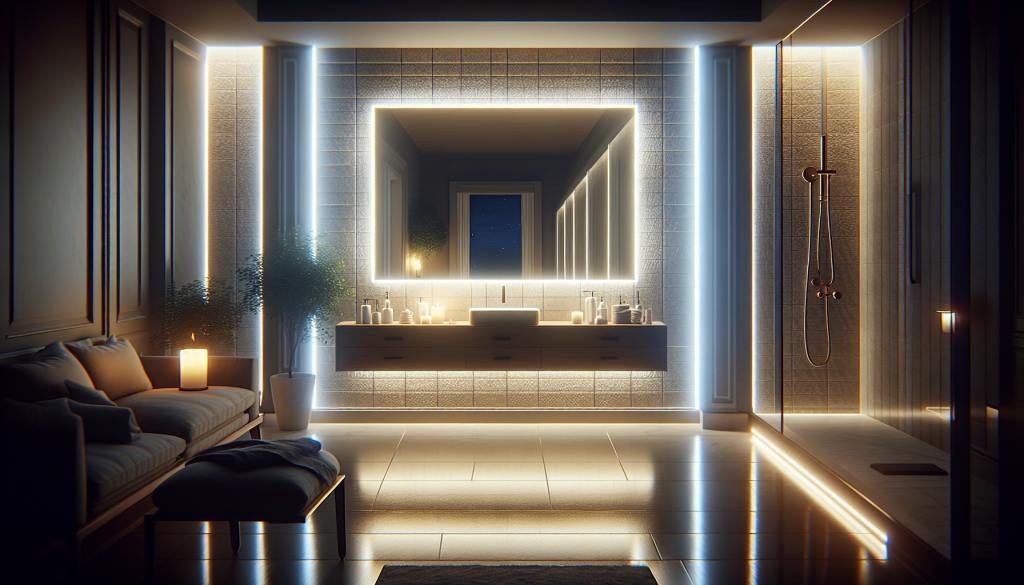
3. Types of LED Bathroom Lighting Fixtures
3.1 Vanity Lights
Vanity lights are an essential component of bathroom lighting, providing both functional lighting for grooming tasks and adding a touch of style to the space. LED vanity lights are available in various styles, including sconces, bar lights, and strip lights. Depending on the size of your vanity and the desired lighting level, you can choose single, double, or even multiple vanity lights for optimal illumination.
3.2 Ceiling Lights
Ceiling lights, such as LED downlights and flush-mounted fixtures, are often used as general or ambient lighting in the bathroom. They provide overall illumination and can be positioned strategically to distribute light evenly throughout the space. LED ceiling lights are available in a range of designs, from simple and minimalist to decorative and modern, allowing you to choose one that complements your bathroom’s aesthetic.
3.3 Mirror Lights
LED mirror lights are designed to illuminate your bathroom mirror, ensuring clear visibility for grooming and applying makeup. These lights can be installed directly on the mirror or on the wall surrounding it. LED mirror lights come in various styles, from backlit mirrors to side-mounted sconces, allowing you to customize the lighting according to your preference and mirror size.
3.4 Accent Lights
To add a touch of ambiance and style to your bathroom, consider using LED accent lights. These lights can be installed under cabinets, along the edges of shelves, or in decorative niches to highlight architectural features or create a focal point. LED strip lights are commonly used as accent lighting due to their flexibility and ability to be hidden discreetly.
3.5 Shower Lights
Incorporating LED lights in the shower area can enhance your bathing experience and provide additional safety. LED shower lights are specially designed to withstand moisture and water exposure. They are installed in the shower ceiling or walls and can provide a soft and relaxing ambiance or bright and invigorating lighting, depending on your preference.
3.6 Task Lighting
Task lighting is crucial for performing specific activities in the bathroom, such as shaving, applying makeup, or styling hair. LED task lights, such as wall-mounted fixtures or adjustable vanity lights, provide focused and bright illumination for these tasks. Consider the placement of these lights to minimize shadows and ensure optimal visibility.
4. Installation and Placement
4.1 Planning the Lighting Layout
Proper planning of the lighting layout is essential for achieving the desired illumination in your bathroom. Consider the various types of LED lighting fixtures you want to incorporate and their optimal placement. Take into account the existing electrical wiring and the locations of switches and outlets. It may be helpful to consult a professional electrician or lighting designer to ensure a well-executed lighting plan.
4.2 Electrical Considerations
When installing LED bathroom lighting, it’s important to consider electrical safety and compliance. Ensure that the circuit can handle the additional load of the LED lights and that the wiring is properly grounded. If you are not comfortable working with electrical systems, it is recommended to hire a qualified electrician to carry out the installation.
4.3 Proper Placement of Fixtures
The placement of LED lighting fixtures plays a significant role in the overall effectiveness and aesthetics of your bathroom lighting. Vanity lights should be positioned at eye level to reduce shadows on the face, while ceiling lights should be spaced evenly to provide uniform illumination. Mirror lights should be mounted at the appropriate height and angle to minimize glare and ensure even lighting across the mirror’s surface. Consider the different layers of lighting and how they work together to create a well-lit and visually appealing bathroom.
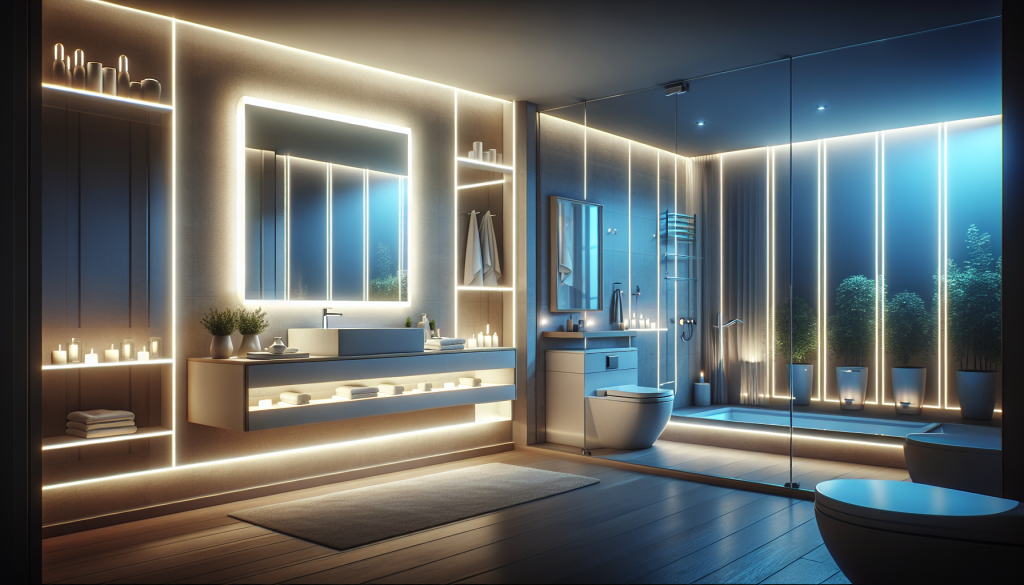
5. Design and Style Options
5.1 Contemporary LED Bathroom Lighting
For a sleek and modern look, opt for contemporary LED bathroom lighting. These fixtures often feature clean lines, minimalistic designs, and innovative shapes. Consider using materials such as brushed nickel or chrome finishes to achieve a contemporary aesthetic. LED strip lights or backlit mirrors can also add a touch of modernity to your bathroom design.
5.2 Traditional LED Bathroom Lighting
If you prefer a classic and timeless style, choose traditional LED bathroom lighting fixtures. Look for fixtures with traditional designs, such as sconces with intricate details or chandeliers with ornate features. Opt for finishes like bronze or brass for an elegant and sophisticated look. Traditional LED lighting can seamlessly blend with various bathroom styles, including vintage or rustic designs.
5.3 Modern LED Bathroom Lighting
For a bold and cutting-edge bathroom style, modern LED bathroom lighting is the way to go. Choose fixtures with sleek lines, unique shapes, and unconventional materials. Look for LED lights with customizable features, such as color-changing options or adjustable brightness levels. Modern LED lighting can transform your bathroom into a contemporary and avant-garde space.
6. Maintenance and Cleaning
6.1 Cleaning Tips
To ensure your LED bathroom lighting remains in optimal condition, regular cleaning is essential. Dust and debris can accumulate on the light fixtures, affecting their brightness and performance. Use a soft, lint-free cloth or a feather duster to gently remove any dust or dirt from the surfaces of the LED lights. Avoid using harsh chemicals or abrasive cleaning agents, as they can damage the fixtures.
6.2 Replacement and Upkeep
LED lights have a longer lifespan compared to traditional lighting options, but eventually, they will need to be replaced. The lifespan of LED bulbs can vary depending on usage and quality. It is advisable to keep track of the installation dates and monitor the brightness of the LED lights over time. When a bulb starts to dim significantly or flicker, it is an indication that it needs to be replaced. Always ensure to follow the manufacturer’s instructions for proper replacement and disposal of the LED bulbs.
7. Tips for Creating a Well-Lit Bathroom
7.1 Layering of Lights
To achieve a well-lit bathroom, consider layering different types of LED lights. Use a combination of general lighting, task lighting, and accent lighting to create a balanced and visually appealing environment. General lighting provides overall illumination, task lighting focuses on specific activities, and accent lighting adds depth and ambiance. By incorporating multiple layers, you can create a functional and inviting bathroom space.
7.2 Dimming Options
Installing dimmable LED lights in your bathroom allows you to adjust the brightness according to your preferences and specific needs. Dimming options provide versatility and flexibility, allowing you to create a relaxing atmosphere for a soothing bath or increase the brightness for grooming tasks. Additionally, dimming your LED lights can help conserve energy and extend the lifespan of the bulbs.
7.3 Using Mirrors for Reflection
Maximize the impact of your LED bathroom lighting by strategically placing mirrors to reflect light and enhance brightness. Mirrors can help distribute light throughout the space, making it appear brighter and more spacious. Consider installing larger mirrors or multiple mirrors to amplify the effect of your LED lights. Utilize the reflective properties of mirrors to optimize the illumination in your bathroom.
8. LED Lighting Safety Considerations
8.1 Waterproofing and Moisture Resistance
Given the high moisture levels in bathrooms, it is crucial to choose LED lighting fixtures that are waterproof or have adequate moisture resistance. Look for fixtures with proper IP (Ingress Protection) ratings to ensure they can withstand the humid conditions. It is especially important to choose waterproof fixtures for shower lights and other areas directly exposed to water.
8.2 Proper Connection and Wiring
When installing LED bathroom lighting fixtures, it is essential to follow proper electrical wiring practices to ensure safety. Ensure that the wiring connections are secure and insulated correctly to prevent any electrical hazards. If you are unsure about the electrical requirements or the installation process, consult a licensed electrician for professional assistance.
9. Energy Savings and Environmental Impact
9.1 Lower Energy Consumption
One of the major advantages of LED lighting is its energy efficiency. LED lights consume significantly less energy compared to traditional lighting options, reducing your electricity consumption and saving you money in the long run. By switching to LED bathroom lighting, you can enjoy the benefits of bright and efficient lighting while minimizing your environmental impact.
9.2 Reduced Carbon Footprint
LED lighting contributes to a reduced carbon footprint due to its energy efficiency and lower greenhouse gas emissions. Traditional lighting options, such as incandescent bulbs or fluorescent lights, consume more energy, resulting in increased carbon emissions. LED lights not only decrease your energy consumption but also help to mitigate climate change by reducing your carbon footprint.
10. Comparison with Traditional Lighting Options
10.1 LED vs Incandescent Lighting
LED lighting offers several advantages over incandescent lighting. Incandescent bulbs waste a significant amount of energy as heat, whereas LED lights are more energy-efficient and emit very little heat, making them safer for use in bathrooms. LED lights also have a longer lifespan, reducing the frequency of bulb replacements. Additionally, LED lights are available in a wider range of colors and can be dimmable, allowing for more versatile lighting options.
10.2 LED vs Fluorescent Lighting
Compared to fluorescent lighting, LED lighting is more energy-efficient, has a longer lifespan, and does not contain hazardous materials like mercury. Fluorescent lights can flicker or buzz, which can be irritating in a bathroom setting. LED lights, on the other hand, provide instant brightness and do not flicker, enhancing the overall ambience of your bathroom. LED lights also have better color rendering capabilities, allowing for accurate color representation in the bathroom.


